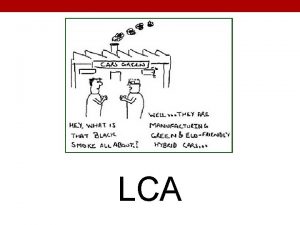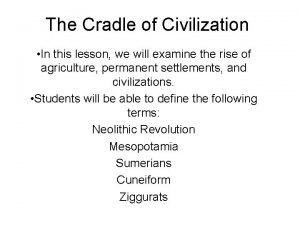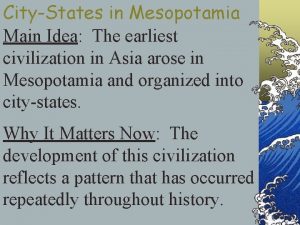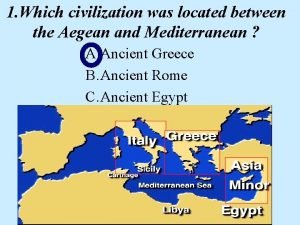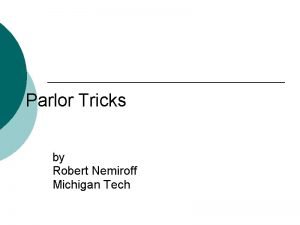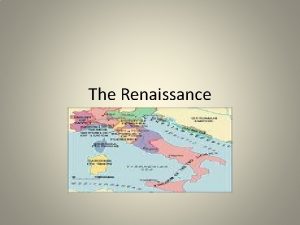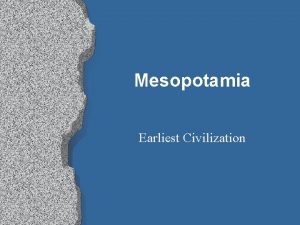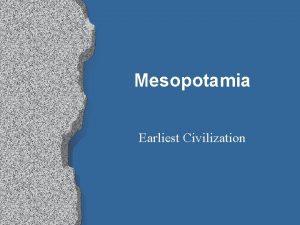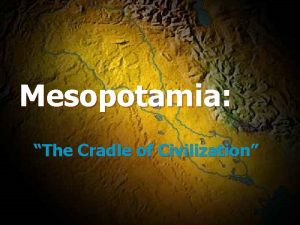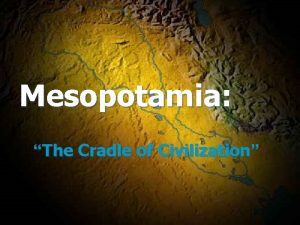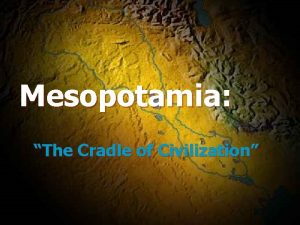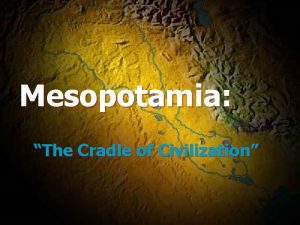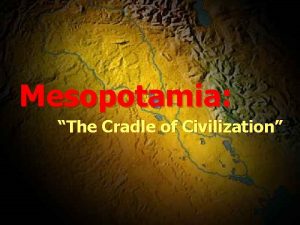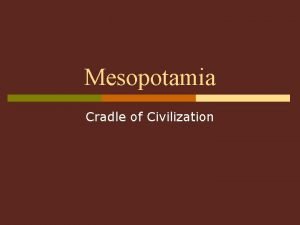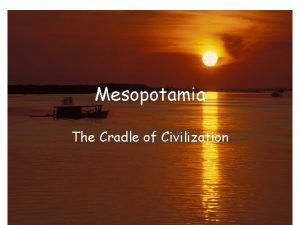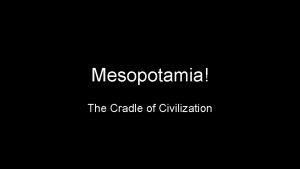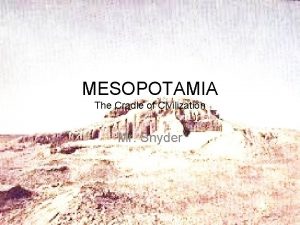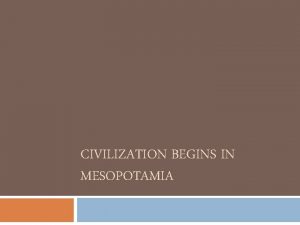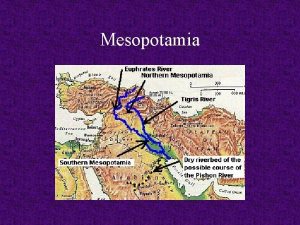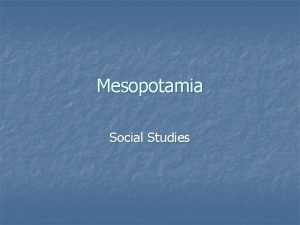MESOPOTAMIA THE CRADLE OF CIVILIZATION The Earliest Civilization





















- Slides: 21

MESOPOTAMIA – THE CRADLE OF CIVILIZATION

The Earliest Civilization � Earliest of all civilizations as people form permanent settlements � “Mesopotamia” is Greek for “between the rivers, ” specifically the Tigris and Euphrates River (now located in present day Iraq)


Geographic Conditions � � � Little rainfall Hot and dry climate (2 rivers surrounded by deserts) Catastrophic flooding of river in spring Windstorms leave riverbed muddy in winter Soil contains little mineral No timber or stone resources

Then Why Settle in Mesopotamia? NATURAL LEVEES: Embankments produced by build-up of sediment over thousands of years

NATURAL LEVEES v Create a high and safe flood plain v Make irrigation and canal construction v Provide protection v. Surrounding swamps full of fish and waterfowl v Reeds provide shelter for sheep/goats v Reeds also used for building

History of Mesopotamia � Over the centuries, several different people civilized this area � SUMER – Southern part (3500 -2000 B. C. E. ) AKKAD – Northern part (2340 -2180 B. C. E. ) BABYLONIA – These 2 regions were unified (1830 -1500 & 650 -500 B. C. E. ) ASSYRIA - Assyrian Empire (1100 -612 B. C. E. ) � � �

Religion Gods were worshipped at huge temples called ziggurats ØPolytheistic religion consisting of over 3600 gods and demigods � Position of King was enhanced and supported by religion � Kingship believed to be created by gods and the king’s power was divinely ordained � Belief that gods lived on the distant mountaintops � Each god had control of certain things and each city was ruled by a different god � Kings and priests acted as interpreters as they told the people what the god wanted them to Ø Gods were anthropomorphic – had feelings like humans Prominent Mesopotamian gods ØEnlil (supreme god & god of air) ØIshtar (goddess of fertility & life ØShamash (god of sun and giver of law)

Ziggurats � � Ziggurat of Ur -2000 BCE � � Large temples dedicated to the god of the city Made of layer upon layer of mud bricks in the shape of a pyramid in many tiers (due to constant flooding and from belief that gods resided on mountaintops) Temple on top served as the god’s home and was beautifully decorated Inside was a room for offerings of food and goods Temples evolved to ziggurats- a stack of 1 -7 platforms decreasing in size from bottom to top Famous ziggurat was Tower of Babel (over 100 m above ground and 91 m base)

� Frequent wars led to the emergence of warriors as leaders � Eventually rise of monarchial system � Co-operation was the basis of government � Followed leadership of god of the city which was interpreted by a council of leading citizens or priests or leader of the city

Sumerians � � � � � Social, economic and intellectual basis Irrigated fields and produced 3 main crops (barley, dates and sesame seeds) Built canals, dams and drainage systems Develop cuneiform writing Invented the wheel Abundance of food led to steady increase of population (farm, towns, cities) First city of the world Developed a trade system with bartering: mainly barley but also wool and cloth for stone, metals, timber, copper, pearls and ivory Individuals could only rent land from priests (who controlled land on behalf of gods); most of profits of trade went to temple However, the Sumerians were not successful in uniting lower Mesopotamia

Akkadians � � � Leader: Sargon the Great Sargon unified lower Mesopotamia (after conquering Sumerians in 2331 BCE) Established capital at Akkad Spread Mesopotamian culture However, short-lived dynasty as Akkadians were conquered by the invading barbarians by 2200 BCE

Babylonians KING HAMMURABI’S BABLYON � � � � (6 th Amorite king) who conquered Akkad and Assyria (north and south) He build new walls to protect the city and new canals and dikes to improve crops Economy based on agriculture and wool / cloth individuals could own land around cities Artisans and merchants could keep most profits and even formed guilds / associations Grain used as the medium of exchange > emergence of measurement of currency: shekel = 180 grains of barley; mina = 60 shekels Mina was eventually represented by metals which was one of first uses of money (but it was still based on grain) Hammurabi’s Legacy: law code

Code of Hammurabi � To enforce his rule, Hammurabi collected all the laws of Babylon in a code that would apply everywhere in the land � Most extensive law code from the ancient world (c. 1800 BCE) � Code of 282 laws inscribed on a stone pillar placed in the public hall for all to see � Hammurabi Stone depicts Hammurabi as receiving his authority from god Shamash � Set of divinely inspired laws; as well as societal laws � Punishments were designed to fit the crimes as people must be responsible for own actions � Hammurabi Code was an origin to the concept of “eye for an eye…” ie. If a son struck his father, the son’s hand would be cut off � Consequences for crimes depended on rank in society (ie. only fines for nobility)

� � � � 10 th century BCE, Assyria emerged as dominant force in the north City of Assur- became important trading and political centre After Hammurabi’s death, Babylon fell apart and kings of Assur controlled more of surrounding area and came to dominate Made conquered lands pay taxes (food, animals, metals or timber) Rule by fear as kings were first to have a permanent army made up of professional soldiers (estimated 200 000 men) Made superior weapons of bronze and iron changed lifestyles in Mesopotamia in weapons and in daily life ie. replaced wooden wheels and applied to horse drawn chariots • Assyrian reunited Mesopotamia and established the first true empire • However, states began to revolt and ONCE AGAIN, Assyrian Empire collapsed by late 7 th century BCE • By 539 BCE, Mesopotamia part of the vast Persian Empire (led by Cyrus the Great) • Persian Empire dominated for 800 years until Alexander the Great

Development Of WRITING

Development of Writing � � � Pictograms: picture to show meaning Ideograms: signs to represent words / ideas Phonetics: signs to represent sounds *Phonetics are the basis of most writing systems

Writing � Greatest contribution of Mesopotamia to western civilization was the invention of writing � allowed the transmission of knowledge, the codification of laws, records to facilitate trade / farming � Sumerians wrote on wet clay tablets with the point of a reed > then dried in the sun to make a tablet � Scribes were only ones who could read and write and served as priests, record keepers and accountants � As society evolved, the first form of writing was developed called CUNEIFORM (meaning “wedge shaped”), dating to 3500 BCE � Cuneiform spread to Persia and Egypt and became the vehicle for the growth and spread of civilization and the exchange of ideas among cultures

Gilgamesh � Gilgamesh is an ancient story or epic written in Mesopotamia more than 4000 thousand years ago � Gilgamesh is the first known work of great literature and epic poem � Epic mentions a great flood � Gilgamesh parallels the Nippur Tablet, a six-columned tablet telling the story of the creation of humans and animals, the cities and their rulers, and the great flood � ANALYSIS Gilgamesh and the Nippur tablet both parallel the story of Noah and the Ark (great flood) in the Old Testament of the Jewish and Christian holy books � Modern science argues an increase in the sea levels about 6, 000 years ago (end of ice age) � the melting ice drained to the oceans causing the sea level to rise more than ten feet in one century

Royal Tombs of Ur � From 1922 to 1934, excavation of the ancient Sumerian city of Ur � City famed in Bible as the home of patriarch Abraham � discoveries such as extravagant jewelry of gold, cups of gold and silver, bowls of alabaster, and extraordinary objects of art and culture � opened the world's eyes to the full glory of ancient Sumerian culture Great Death Pit � mass grave containing the bodies of 6 guards and 68 servants � grave was a great funeral procession � drank poison, choosing to accompany the kings and queens in the afterlife

Legacies of Mesopotamia Revolutionary innovations emerged in Mesopotamia such as: � Codified laws � Ziggurats � Cuneiform � Irrigation � Metal working, tools � Trade � Transportation � Wheel � Mathematics � Prosperous living based on large scale agriculture
 Mesopotamia the cradle of civilization worksheet answers
Mesopotamia the cradle of civilization worksheet answers Cradle to grave housing report
Cradle to grave housing report Cradle to cradle design
Cradle to cradle design Cradle to grave cradle to gate
Cradle to grave cradle to gate Bedankt
Bedankt The cradle of civilization
The cradle of civilization The earliest civilization in asia arose in
The earliest civilization in asia arose in The earliest aegean civilization was located
The earliest aegean civilization was located Introduction of mesopotamian civilization
Introduction of mesopotamian civilization Newton's cradle tricks
Newton's cradle tricks Beef skinning cradle
Beef skinning cradle Leg cradle to lateral lunge
Leg cradle to lateral lunge Okonkwo's achievements and status
Okonkwo's achievements and status What are the influences of rizal during his childhood
What are the influences of rizal during his childhood Cradle to grave
Cradle to grave Golden cradle kindergarten
Golden cradle kindergarten Cradle of the renaissance
Cradle of the renaissance Scholarship merit badge
Scholarship merit badge Cradle alignment techniques
Cradle alignment techniques Fry pan bottom candlestick pattern
Fry pan bottom candlestick pattern Cradle to grave
Cradle to grave Newton's cradle
Newton's cradle



